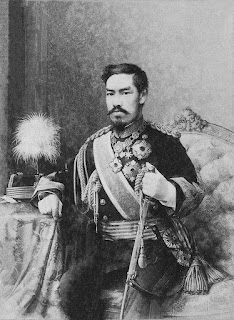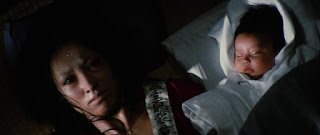Asura Snow
1. Meiji Japan
Emperor Kōmei succumbed to smallpox on January 30th, 1867. The Edo period died with him. His fourteen year old son Prince Mutsuhito assumed the Chrysanthemum Throne on October 23, 1868 and was re-christened “Emperor Meiji.” Too young to govern at the time of his ascension, the child emperor’s advisors assumed control of Japan and quickly set about modernizing the island nation: old systems of feudal hierarchy were abolished, the so-called “evil customs” of the past were broken off, and thus were the foundations of imperial rule laid.
 |
| Emperor Meiji |
Early Meiji reformers believed such reforms were necessary for achieving diplomatic equality and military strength. The motto of the era was “Enrich the Country and Strengthen the Military.” Emperor Meiji embodied these efforts. He wore Western-style military clothing, styled his hair after the Western fashion, and grew a kaiser mustache all in an effort to appear more “civilized” to the outside world.
2. Lady Snowblood
Toshiya Fujita’s 1973 Lady Snowblood (based on Kazuo Koike and Kazuo Kamimura’s manga of the same name) is set during Emperor Meiji’s reign, and is in many respects a direct challenge to the 1868 Charter Oath that outlined the reforms mentioned above. In the film, Sayo Kashima’s husband and son are murdered by a gang of four criminals who are running a draft-dodging scam on illiterate villagers. Sayo is taken captive and raped repeatedly by the gang members. She manages to kill one of them, but is caught and imprisoned before she can finish off the other three.
 |
| "You will carry on my vendetta. My poor child..." |
While in prison, Sayo seduces countless guards so that she may have a child to avenge her, her husband, and her son. She succeeds, and Yuki Kashima is born. Sayo dies in childbirth, leaving Yuki an orphan. Sayo’s vendetta is Yuki’s unhappy inheritance. Yuki is raised by the Buddhist priest Dōkai as an asura--the living avatar of her mother’s vengeance. Yuki is an anachronism: decades long blood feuds, katanas, and Buddhist demons are all woefully out of place in Emperor Meiji’s new Japan. She is a being out of time; a Faulknerian ghost who reminds us that “the past is never dead, it’s not even past.”
3. “The Masque of the Red Death”
The final confrontation with Gishirō at the masquerade distills these sentiments. By the time Yuki catches up with him, Gishirō has gone straight. More or less. He is a gun runner, and no-one in Japan, not even the military, can sell a rifle without him knowing it. And it is men like him who ultimately benefit from Meiji’s reforms. Rapists. Murderers. Opportunists.
 |
| Gishirō at the masquerade |
It is a voluptuous scene, that masquerade. Every bannister is festooned with a different nation’s flag. Here, the stars and stripes; there the Union Jack. The clothes of the attendees eschew the barbarous and the oriental. In their stead one finds the height of Western sophistication: Prussian military duds for the men and Parisian couture for the ladies. The revellers would mark Yuki even if her distinctly Japanese vesture were not dabbled in blood--and her fair features besprinkled with the scarlet horror. Her presence is an indictment of their piggish decadence. And she makes them pay.
 |
| Meiko Kaji as Yuki Kashima--"Lady Snowblood" |



Comments
Post a Comment